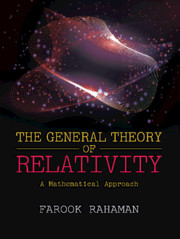Book contents
- Frontmatter
- Dedication
- Contents
- List of Figures
- List of Tables
- Preface
- Acknowledgments
- Chapter 1 Tensor Calculus — A Brief Overview
- Chapter 2 Geodesic
- Chapter 3 Einstein Field Equations
- Chapter 4 Linearized Gravity
- Chapter 5 Lie Derivatives and Killing’s Equation
- Chapter 6 Spacetimes of Spherically Symmetric Distribution of Matter and Black Holes
- Chapter 7 Particle and Photon Orbits in the Schwarzschild Spacetime
- Chapter 8 Causal Structure of Spacetime
- Chapter 9 Exact Solutions of Einstein Equations and Their Causal Structures
- Chapter 10 Rotating Black Holes
- Chapter 11 Elementary Cosmology
- Chapter 12 Elementary Astrophysics
- Appendix A Extrinsic Curvature or Second Fundamental Form
- Appendix B Lagrangian Formulation of General Relativity
- Appendix C 3+1 Decomposition
- Bibliography
- Index
Chapter 8 - Causal Structure of Spacetime
Published online by Cambridge University Press: 24 March 2021
- Frontmatter
- Dedication
- Contents
- List of Figures
- List of Tables
- Preface
- Acknowledgments
- Chapter 1 Tensor Calculus — A Brief Overview
- Chapter 2 Geodesic
- Chapter 3 Einstein Field Equations
- Chapter 4 Linearized Gravity
- Chapter 5 Lie Derivatives and Killing’s Equation
- Chapter 6 Spacetimes of Spherically Symmetric Distribution of Matter and Black Holes
- Chapter 7 Particle and Photon Orbits in the Schwarzschild Spacetime
- Chapter 8 Causal Structure of Spacetime
- Chapter 9 Exact Solutions of Einstein Equations and Their Causal Structures
- Chapter 10 Rotating Black Holes
- Chapter 11 Elementary Cosmology
- Chapter 12 Elementary Astrophysics
- Appendix A Extrinsic Curvature or Second Fundamental Form
- Appendix B Lagrangian Formulation of General Relativity
- Appendix C 3+1 Decomposition
- Bibliography
- Index
Summary
Introduction
From a physical point of view, an outcome cannot occur before its cause. In special relativity, by causality we mean that an outcome cannot occur from a cause that does not lie in the back (past) light cone of that event. Likewise, a cause cannot affect outside its front (future) light cone. These limitations are expected as causal impacts cannot propagate quicker than the speed of light and/or backward in time. Usually, in relativity, the spacetime is characterized by a Lorentzian manifold. Actually, a Lorentzian manifold is a specific case of a pseudo-Riemannian manifold, where the signature of the metric is +2 or –2. Generally, the causal relationships among the points in the manifold are understood by defining which events in spacetime can affect which other events. Causal structures in Minkowski spacetime assume, naturally, a simple form as the spacetime is flat. However, the causal relationships between points of the curved spacetime will be more complicated due to the presence of curvature. The description of the causal structure in curved spacetime is expressed in terms of smooth curves joining pairs of points. The causal relationship is defined by the conditions on the tangent vectors of the curves. In general relativity, the metric of the spacetime up to a conformal factor can be recuperated from the causal structure. In this chapter, we explore different properties of such causal relationships instituting a number of results that will be used for advanced topics in general relativity, particularly to prove the existence of singularities.
Causality
Causal structure in the special theory of relativity, i.e., in Minkowski spacetime or flat spacetime is characterized by the fact that no massive particle can travel faster than light. In general relativity, also, locally there is no difference between the causality relation with that in Minkowski spacetime. However, globally the causality relation is significantly different due to various spacetime topologies.
Let (M, gab) be a spacetime that is connected, Hausdorff, paracompact, and admits a Lorentzian metric gab of signature (+, -, -, -). Let p be an arbitrary event in M, then the tangent space Vp is isomorphic to Minkowski spacetime. As a consequence, one can note that the light cone of p is a subspace of Vp.
Information
- Type
- Chapter
- Information
- The General Theory of RelativityA Mathematical Approach, pp. 187 - 218Publisher: Cambridge University PressPrint publication year: 2021
Accessibility standard: Unknown
Why this information is here
This section outlines the accessibility features of this content - including support for screen readers, full keyboard navigation and high-contrast display options. This may not be relevant for you.Accessibility Information
- 2
- Cited by
